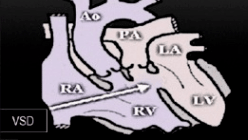Taussig–Bing syndrome
| Taussig–Bing syndrome | |
|---|---|
 | |
| Taussig–Bing anomaly double-outlet right ventricle with sub-pulmonic ventricular septal defect | |
| Specialty | Cardiac surgery |
Taussig–Bing syndrome is a cyanotic congenital heart defect[1] in which the patient has both double outlet right ventricle (DORV) and subpulmonic ventricular septal defect (VSD).[2]
In DORV, instead of the normal situation where blood from the left ventricle (LV) flows out to the aorta and blood from the right ventricle (RV) flows out to the pulmonary artery, both aorta and pulmonary artery are connected to the RV, and the only path for blood from the LV is across the VSD. When the VSD is subpulmonic (sitting just below the pulmonary artery), the LV blood then flows preferentially to the pulmonary artery. Then the RV blood, by default, flows mainly to the aorta.
The clinical manifestations of a Taussig-Bing anomaly, therefore, are much like those of dextro-Transposition of the great arteries (but the surgical repair is different). It can be corrected surgically also with the arterial switch operation (ASO).
It is managed with Rastelli procedure. It is named after Helen B. Taussig and Richard Bing, who first described it in 1949.[3]
References
- ↑ Konstantinov, Igor E. (2009). "Taussig-Bing Anomaly". Texas Heart Institute Journal. 36 (6): 580–585. ISSN 0730-2347. PMC 2801930. PMID 20069085.
- ↑ Ramrakha, Punit S.; Ramrakha, Punit; Hill, Jonathan (2012). Oxford Handbook of Cardiology. OUP Oxford. p. 707. ISBN 9780199643219.
- ↑ Konstantinov, Igor E. (2009). "Taussig-Bing Anomaly". Texas Heart Institute Journal. 36 (6): 580–585. ISSN 0730-2347. PMC 2801930. PMID 20069085.
External links
| Classification | |
|---|---|
| External resources |